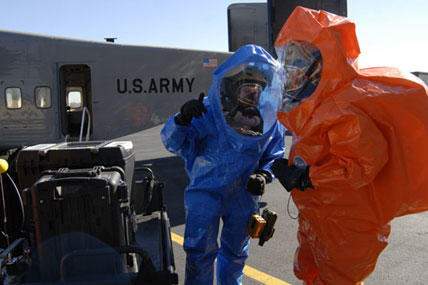It has been outlawed since 1993, but the recent conflict in Syria has put sarin back on the list of deadly weapons purportedly used by regimes in the Middle East.
A Senate panel voted Wednesday to give President Obama the authorization to launch a military strike against Syria for allegedly carrying out an Aug. 21 chemical weapons attack on its own citizens. The U.S. is accusing Syrian President Bashar al-Assad's government of using sarin on civilians in an attack that killed more than 1,400 men, women and children.
If the claims are true, this was the first time sarin has been used on such a massive scale since the deadly nerve agent was outlawed by the Chemical Weapons Convention of 1993. Iraqi forces employed sarin several times against Iranian soldiers in 1988 at the end of the Iran-Iraq War.
Sarin first appeared in 1938 when it was developed by German scientists as a pesticide before being transferred to chemical warfare section of the German Army Weapons Office the following year. The man-made substance didn't go into mass production, however, until 1944 as World War II drew to a close.
NATO adopted sarin as a standard chemical weapon in 1950. The Soviet Union and the United States produced and stockpiled sarin for decades afterwards.
Sarin has been used in small-scale attacks such as the one in 1995 that killed 13 people in the Tokyo Metro.
It appears that sarin was used on a much larger scale in Syria. A nine-page French intelligence report maintains that Assad's forces launched ground and air attacks involving the "massive use of chemical agents" on several suburbs in Damascus, according to a Sept. 2 New York Times story.
"Sarin is a clear, colorless, and tasteless liquid that has no odor in its pure form," according to the Center for Disease Control. "Sarin is the most volatile of the nerve agents. This means it can easily and quickly evaporate from a liquid into a vapor and spread into the environment."
Since it evaporates so quickly, sarin presents an immediate but short-lived threat. Recovery from sarin exposure is possible with treatment, but to be effective, the antidotes available must be used quickly, the CDC states.
Victims exposed to large doses of sarin will experience convulsions, paralysis and respiratory failure.
Like all nerve agents, sarin prevents "the proper operation of an enzyme that acts as the body's ‘off switch' for glands and muscles," according to the CDC. Without an ‘off switch,' the glands and muscles are constantly being stimulated.
"People exposed to a low or moderate dose of sarin by breathing contaminated air, eating contaminated food, drinking contaminated water, or touching contaminated surfaces may experience" headaches, blurred vision, drooling or excessive sweating, chest tightness, rapid breathing, nausea and confusion.
The effects of sarin can be spread by coming in contact with a victim's clothing.
"If people think they may have been exposed, they should remove their clothing, rapidly wash their entire body with soap and water, and get medical care as quickly as possible," the CDC reports. "Mildly exposed people usually recover completely. Severely exposed people are less likely to survive."






























